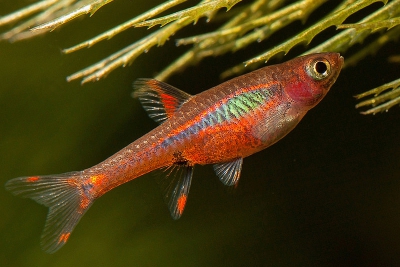Introduction
Sphaerichthys vaillanti is a little fresh water fish from the Asia.
This sheet is currently being prepared. The texts currently proposed come from our data model or are being drafted. To request priority for this content, you can write to us HERE.
Who is it?
Morphology
-
Average size3 cm
-
Maximum size4 cm
-
Longevity3 year
-
Mimicryleaf
-
Average size3 cm
-
Maximum size4 cm
-
Longevity3 year
-
Mimicryleaf
How to recognize This fish ?
Like all fish of its genus, Sphaerichthys vaillanti has the particularity of being able to breathe in two different ways. In addition to the classic gills, this species is equipped with a breathing apparatus called Labyrinthe which allows it to absorb oxygen from the air. These species are commonly called the labyrinth Fish.
Sphaerichthys vaillanti measures between 3 and 4 cm. Given its small size, this species is commonly referred to as a "dwarf" animal. This fish is bicolore with a predominantly marron and beige body.
Behaviour & Life cycle
-
dietcarnivorous
-
Sociabilityliving in small groups
-
territorialYes
-
Way of livingdiurnal
Sphaerichthys vaillanti is a fish living in small groups naturally found mid-depth and near surface. The members of each group are organized around a well established hierarchy. This species is carnivorous . Measuring only a few centimeters, this small species tends to be discreet and hide in the presence of larger neighbors.
Although slightly territorial, Sphaerichthys vaillanti is a rather peaceful animal that generally behaves in a peaceful manner with other species. It should be noted that it is sometimes less tolerant with its conspecifics. Parades or even small jousts may occur between different members of the group until a hierarchy is established.
Reproduction
-
Reproductionovipare incubateur buccal
Sphaerichthys vaillanti is a fish ovipare incubateur buccal.
Harmless species
This species does not represent any particular threats to humans when encountered in its natural environment.
Origin and distribution
What is its habitat?
Natural environment characteristics
-
Temperature26 - 30 °C
-
pH (acidity)3.5 - 6.5
-
gh (hardness)1 - 4
-
FlowSlow and Stagnant
Biotope presentation
The acidification of water comes from the decomposition of plants. This phenomenon changes the color of the water, which tends to turn brown. In some areas particularly rich in organic matter, the water is so dark that it is called "black water".
During dry periods, Sphaerichthys vaillanti may find themselves isolated in marshes and small water holes with little oxygen. Its ability to gasp for air at the surface allows it to resist until the next season.
Species of the same biotope
Main recommendations for fishkeeping
Deontology
In order to preserve wildlife, if you acquire this animal, it must not be released into the wild. See also, the Fishipedia charter.
Fishipedia supports the practice of responsible and environmentally friendly aquarium keeping. We encourage maintenance if it is motivated by a desire to understand the biological functioning of living things and if it is done with respect for animal life.
We believe that aquaristics is an opening to the discovery of aquatic environments, especially freshwater, and that this knowledge is necessary to better protect and respect these environments. Logically, we refute the compulsive purchase of animals that would not find a sufficient and / or adapted place in the host aquarium.
Our recommendations
-
Min volume60 liters
-
Population min2
-
Temperature26 - 30 °C
-
pH (acidity)3.5 - 6.5
Characteristics
-
Difficulty breedinghard
-
Robustnesssensible
-
Behaviourpeaceful
-
Availabilityrare
Recommended equipment from our partners
-
Aquarium
-
Filtration
General reminders
It is strongly advised to read the complete dedicated file and to get information on the feedbacks of maintenance of the envisaged animal, this to avoid any potential conflict whose end result is generally the death of the individual (or the other inhabitants). It is important not to overload your aquarium to limit pollution. This will make maintenance easier.
In nature, animals are subject to weather conditions and live in waters with variable characteristics. The recommendations offered by our team for aquarium maintenance are a guidance and cannot be assimilated to scientific datas.
General reminder on maintenance datas
Le démarrage d'un aquarium est une partie primordiale pour l'équilibre et le bien-être des poissons. Lorsque l'on met en eau un aquarium, l'eau passe naturellement par un cycle biologique : le cycle de l'azote. Celui-ci dure environ trois semaines. Tous les 2 jours, nous vous conseillons de tester votre eau jusqu'à ce que le taux de nitrite soit à zéro pendant plusieurs jours d'affilée.
Pour accélérer ce cycle, vous pouvez utiliser un activateur de bactéries comme JBL Denitrol. Cette solution riche en bactéries vivantes et enzymes permet une mise en place rapide du cycle de l'azote. Les poissons peuvent alors être introduits plus rapidement.
Il est important de tester l'eau de son aquarium régulièrement pour maintenir un environnement sain pour les poissons et les autres habitants. Les tests d'eau permettent de mesurer les niveaux de différents paramètres tels que le pH, la dureté totale, ainsi que les taux de nitrates, de nitrites et d'ammoniaque.
Pour réaliser ces tests, vous pouvez utiliser des produits d'analyse spécialisés tels que JBL ProScan qui permet de réaliser un diagnostic de l'eau directement via un smartphone. Il existe également des coffrets de tests plus classiques de bandelettes, comme JBL PROAQUATEST.
En cas d’usage de l’eau du robinet, vous pouvez utiliser un conditionneur d’eau de type Biotopol de JBL pour éliminer les substances nocives comme le chlore, le cuivre, le plomb et le zinc. Une eau trop dure ou trop calcaire peut être inadaptée à de nombreuses espèces tropicales d’eau douce. Si nécessaire, vous pouvez la couper avec de l’eau osmosée ou de pluie filtrée afin d’obtenir une dureté plus adaptée aux besoins de vos poissons et de vos plantes. Les conditionneurs d'eau garantissent une meilleure santé aux poissons et une meilleure croissance des plantes.
Chlorine and chloramine are dangerous for the health of animals. Used to disinfect water, these agents are present in significant quantities in tap water. We recommend using an anti-chlorine agent every time you change the water. In addition to chlorine, treatments and medicines sold for aquarium use sometimes contain dangerous heavy metals in high doses.
Specific needs for Sphaerichthys vaillanti
Sphaerichthys vaillanti is a species which lives naturally at a temperature between 26 °C and 30 °C. Sphaerichthys vaillanti is sensitive to abrupt changes in parameters as well as to chemicals. Its acclimation in an aquarium must be done with special care to prevent it from developing diseases or weaknesses. Nitrate levels should remain below 25mg/L. To keep the water clean and unpolluted, plan on changing 20% to 30% of the water volume each month.
Sphaerichthys vaillanti is a species whose maintenance is rather reserved for informed aquarists . It can only be successfully carried out by carrying out a minimum of documentation work. Special husbandry conditions can easily lead to the death of the species.
This species is very rare in the aquarium trade. Instead, it is maintained by knowledgeable aquarists who own and breed individuals from wild origin strains. If you want to get this species, we advise you to contact specialized clubs. }Specimens from long time breeding are a bit easier to breed but you have to respect the particular water parameters.
Fish with a maze
The ability to breathe at the surface makes this fish more likely to live in small volumes. Naturally, Sphaerichthys vaillanti can be found for long periods in water holes where oxygen is scarce.
Cohabitation & Environment
Sphaerichthys vaillanti is a fish which it is advisable to maintain in specific aquarium. Associating it with other species is not fundamentally impossible but a documentation work is necessary for the constitution of the population. Being a living in small groups fish, it is advisable to install at least 2 individuals in an aquarium of 60 liters minimum (for 80 cm of frontage). Group maintenance is a prerequisite to ensure their well-being. Lonely individuals tend to quickly become stressed and become especially susceptible to disease.
It should be noticed that this species should not be kept with large crustaceans or fish, as it would become a prey of choice. Smaller species should preferably be inserted in the aquarium some time before the larger ones. Moreover, if you want to breed it, it is better to put them in a specific aquarium.Acid Water Maintenance
Sphaerichthys vaillanti living naturally in acidic water, generally in "black" or "sieved" water, the implementation of a filtration on peat is ideal for its balance. Adding decaying leaves and alder fruit can significantly improve living conditions by naturally increasing acidity of some water.Tips for feeding
Sphaerichthys vaillanti is carnivorous.
This species does not appreciate being fed with freeze-dried food (flakes...). Some specimens will never eat this type of food.
Feed animals in moderation to maintain good water quality. Meals should be eaten within 2–3 minutes, served in several small portions rather than a single large ration.
Uneaten food quickly decomposes, releasing ammonia, nitrites, and nitrates, which disturb the aquarium’s biological balance.
Make sure each species can access food properly, slower or bottom-dwelling individuals may require targeted feeding.Food recommendations from our partner JBL - Products PRONOVO
-
Granules
-
Flakes
-
Sticks
Reproduction protocol
-
Maintenance difficultyhard
-
egg-laying protectionYes
Reproduction of this species in an aquarium is considered hard. Ideally, it takes place at a temperature of around 28 ° C for a pH of 4.5 .
Hybridization risks
In general, it is advised not to mix several species of the same genus or different varieties of the same species, to avoid the risks of hybridization.
These animals might interest you
These plants might interest you
Plants play a crucial role in aquariums, both for their ability to filter water by absorbing excess nutrients and for their aesthetic contribution. They provide fish with natural hiding places, can serve as breeding sites, and generally help maintain the overall balance and optimal conditions of the aquarium. The selection presented here includes species from the same regions as the species described on this page, although they do not necessarily come from its exact natural biotope.
To go further
Sources & Contributions
Participation & Validation
The Fishipedia team and specialist contributors are committed to providing high-quality content. However, although the information comes from scientific sources or testimonials from specialists, the cards may contain inaccuracies.

Benoit Chartrer

Sylvain Mathieu
Translation
Translation done with the valuable contribution of our translators, who make this information available to a wider audience. We sincerely thank them for their commitment.
Bibliographic references
- - GBIF
- - The Anabantoid Genera Ctenops, Luciocephalus, Parasphaerichthys, and Sphaerichthys (Teleostei: Perciformes) as a Monophyletic Group: Evidence from Egg Surface Structure and Reproductive Behaviour - Ralf Britz - Michael Kokoscha - Rudiger Riehl - - 1995.
Scientific partners
Species of the same family
Species of the same biotope







































